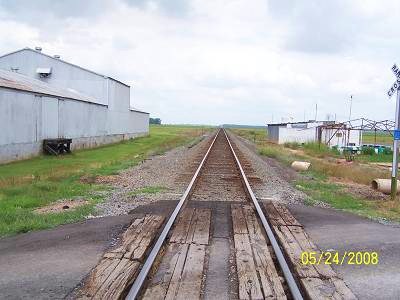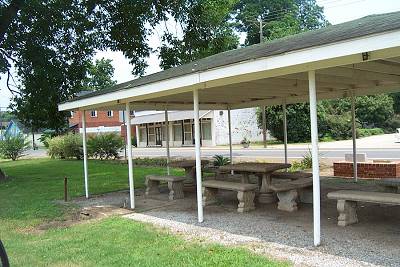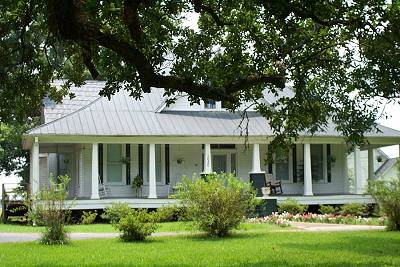I'd mentioned heading up to Cheneyville when we were talking with the owner of the Bailey Hotel in Bunkie, now closed. He'd said something about Civil War bullets or shrapnel in the front door of the very old Episcopal church there. I was familiar with the church but had never heard that story. We would have to check it out. Sitting on the porch of the Bentley was nice, but it was time to go or get a room.
You can travel two ways from Bunkie to Cheneyville. One is US 71 and another is by Shirley Plantation Road (La.1177) that rides along Bayou Boeuf. This area is as up front"Central Louisiana" as it gets. From large country churches and small field workers' homes to large plantations with "big houses" resplendent with all the Greek antebellum trappings, to small cottages, this is Cotton Louisiana though the crop is changed when financial considerations prevail. The ghosts of the Old South ride the breezes blowing across the fields, under the oaks and between the giant cedars.
It's a place where you can imagine hearing Pearl Bailey (no relation) singing "Summer Time". It's a place where the fictional portrayals of "Long Hot Summer" and "Steel Magnolias" wouldn't be fictional at all, but scenes from everyday life.
I once chased bayous and rivers. These are a few personal words about this area from a long ago memoir.
Revisiting visions of the past becomes more important as those visions become more distant.
In my youth, my family traveled the length of the state in order to see our relatives. I learned the roads: US 61 from New Orleans to Baton Rouge, US 190, from Baton Rouge to its intersection with US71, west of Krotz Springs, US 71, from 190 to Alexandria, and La.1, or US 71, sometimes, from Alex (La. shorthand) to Shreveport. Extreme boredom would cause my father to alternate. Between comic books and throwing up, I watched the sides of the roads, always wishing I could get off this worn path and explore down the little roads. I knew adventure and treasure were out there. What I didn't know was how close to that worn route those treasures would be.
The trips would only get interesting, to me, when we finally got into the hills of north La. We had always lived on flat land. The hills were different and like that part of Shreveport where my grandmothers both lived. You could skate, at speed, on Wilkinson Street.
Now, I am roaming those once hated flat lands that Bayou Boeuf and Cocodrie tie together. US 71, south of Alexandria, once considered an endless stretch of the trip, La.29, south of Bunkie, and La.182, south of Whiteville to Washington where the Cocodrie and Boeuf join to form Bayou Courtableu. This area defines a distinct region. It is a region of transition. Homes define the culture and the styles change gradually along these routes. It begins with very Central Louisiana, traditional mid western farm houses changing to the Cajun homes further south, marked by their exterior staircases to the attic. Large Greek Revival plantations are scattered throughout. In reality, there is no defining border between cultures and architecture, only a weighting from one group to another. Louisiana is the ultimate poorly stirred mixing bowl.
So here I go again up 71. If you are reading this little tale in expectation of twisting, thrilling travel. Sorry. If you want to see what I consider treasures, yes, a lot of rotting houses, slimy bayous, and graves, you're at the right place. I feel like I have to do it all before I can start on the hills. Those past visions do get much more interesting when revisited. And, those distant treasures seen as a blur from an un-air-conditioned '49 Dodge weren't so distant after all. In many cases they lay just a few feet away from what I consider Louisiana's other "Mother Road", US 71, US 1 being, "Mom".
That was from "a while back".
Cheneyville
From the hotel I brought the fellas up 1177 which is the west route up the Boeuf. I told one of them, when asked, what bayou that was, "If you see a bayou, call it the Boeuf because it twists around all over this alluvial plain and you'll probably be right".

The bayou.
.jpg)
Not a Greek, but maybe antebellum.
.jpg)
This is the country church I had in mind. It was letting
out when we passed by. I can't describe the scene.
.jpg)
One of the freedoms which I hold dearest is my freedom to
change my mind. I think that, to avoid redundancies, I'll move
forward with hometown lady, Mary Marks Soloman's pamphlet
on Cheneville and fill in between her paragraphs with pictures
and my comments.




.jpg)


_(400_x_400).jpg)
.jpg)
.jpg)


{Photos needed}

_(400_x_400).jpg)




Below the railroad is mentioned. I spent some time
in Cheneyville trying to figure out how the Southern
Pacific met the Texas & Pacific. It was a hot long
afternoon similar to this one.
_(400_x_400).jpg)
I was heartened by torn up ties. I could lead you to believe
these were from the SP, not so. Still, they were a mood
setter.
_(400_x_400).jpg)
Before the hunt on the south side of the tracks began, I
looked up and down the north side. I couldn't see the connection
from that side. The high weeds, below on the right, marked
the spot.
.jpg)
The truth lay beyond the rails.
.jpg)
Looking north.
.jpg)
Looking south.
.jpg)
.jpg)
.jpg)
Then I went into the farmer's field. The GPS said I was there.
The farmer knew they were there, also.
.jpg)
.jpg)
.jpg)
The next stops would be Haas and Eola to the south.

I'll pop in a few pictures of Front Street, US 71.
Some are older, some are more recent. Some depict
how Cheneyville has deteriorated quickly in the last
of the 20th and the beginning of the 21'st Centuries.
Her most recent loss has been the parish jail, once a school.
There is not much left alive in Cheneyville.
Below was found where she describes "Old Town" as being.

This may or not be of what she is speaking.
.jpg)
Not all the homes were in bad shape.
.jpg)
This is the present Methodist Church. That is my guess
based on its design.
.jpg)
.jpg)
Here's the old dominoes pavilion on Front Street near
the railroad tracks. Once it was a place where old men
played the day away.
.jpg)
Now, it's not. They are dead and so is the town.
_(400_x_400).jpg)
This shot was taken from there.
_(400_x_400).jpg)
A lovely place.
.jpg)
Old businesses.
.jpg)
This is one of the once busy antique shops.
.jpg)
This was once a home near the tracks.
.jpg)




This picture was taken on the mushroom ride. It is not
my best. Below it will be better.
.jpg)
.jpg)
_(400_x_400).jpg)
.jpg)
I had mistaken this tour sign for the Northup Tour.
The Bennett places were on the Northup Tour, named
for a man who had been kidnapped into slavery in these
regions. Much more on that later.
.jpg)
.jpg)
.jpg)
.jpg)

.jpg)
Of course that's the Boeuf.
.jpg) '
'Notice the use of the word, "Planter". He was not a farmer.
Farmers are workers. The "Planter" may have dallied in
the soil from time to time, but it was not his job. He had
overseers for that.
.jpg)
This house sat nearby. I suspect it had something to do
with the cemetery.
.jpg)
The author is black, thus the familiarity with the historical
places of interest to that community.

What was the "Alliance"?
{Photos needed}
.

I was in the Bennett Store a while back. It was the last
opportunity to visit it while it was there. I wonder if the
ghosts made the trip?
_(400_x_400).jpg)
Now the store and house are saved, elsewhere.
_(400_x_400).jpg)
This is the way it looked in the state I found it on US 71.
.jpg)
I was afraid to go upstairs. Shame on me.
.jpg)
Looking out the side. That is a kitchen in green.
.jpg)
Across the highway was the family home.


The Cheneyville Horror?
_(400_x_400).jpg)
In response to my long ago write, a reader, Ms. June wrote,
" Your site and photos brought back so many good
memories of my childhood in Cheneyville, Louisiana.
I wanted to give you the story about the house and
store on page 2 of your Alex to Washington trip.
That's the old Bennett house and store. My friend
Veronica grew up in that house. She once told me
that the house had at one point been a funeral
parlor. She may have just said that to scare me
though!" [The store and house are two different
places.
"The store was vacant and we played in there often.
Someone found a box of receipts including one from
1817 (when the store was new) that showed James
Bowie shopped there; he invented his knife nearby
and once owned a lot in Cheneyville".
"We never went up those stairs either! Ezra Bennett
came from New York and bought the house and store
in the 1830s. He is buried in the graveyard over
by Trinity Episcopal Church. I'm so sad to see the
house and store are in ruins now. I wish someone
would restore them".
"Thanks for the photos and the trip back in time. :) "
Ms. June, you got your wish.
Here's a bit about Bowie's presence in the area.
"In his teens James Bowie worked in Avoyelles and Rapides parishes, where he floated lumber to market. He invested in property on the Bayou Boeuf and traded in 1817–18 at what is now Bennett's Store, south of Cheneyville. He was fond of hunting and fishing, and family tradition says that he caught and rode wild horses, rode alligators, and trapped bears. When grown, Bowie was described by his brother John as "a stout, rather raw-boned man, of six feet height, weighed 180 pounds." He had light-colored hair, keen gray eyes "rather deep set in his head," a fair complexion, and high cheek-bones. Bowie had an "open, frank disposition," but when aroused by an insult, his anger was terrible. During the War of 1812, James and Rezin joined the Second Division, Consolidated, a unit that contained the Seventeenth through Nineteenth regiments, drawn from Avoyelles, Rapides, Natchitoches, Catahoula, and Ouachita parishes. In January 1815, according to family records, the brothers were on their way to join Andrew Jackson's forces at New Orleans when the war ended".
From Here
Returning to Mary Soloman's pamphlet:


Cheneyville was joined in the anti lottery movement.
This is a little boring but what seems important to
me is the list of prominent people in the community.



That does sound a little familiar. These guys were T Party
People. They saw what crooked government was doing
and found it "repugnant to ur state pride, an insult to
our manhood, abhorrent to public morality, contrary to
our State Constitution, consequently undemocratic and
contrary to all Democratic principles".
I am sure that if you crossed any of these gents, a duel
on the sandbar would be your next invitation.

They saw themselves as leaders.

Of interest here is the mention of the Town Talk, still
Alexandria's newspaper.
The members:

Below is a list of pictures I did not get from my source.



This has been edited and you can thank me for that.